 |

 |
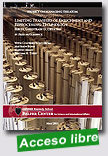 |
Limiting Transfers of Enrichment and Reprocessing Technology: Issues, Constraints, Options
Belfer Center for Science and International Affairs, May 2011, 74 p.
The diffusion of enrichment and reprocessing (E&R) technologies can increase the risk of the proliferation of nuclear weapons in several ways. First, enrichment and reprocessing facilities can produce nuclear materials – highly enriched uranium (HEU) and separated plutonium—that are directly usable in nuclear weapons. With such materials, a state could abrogate its nonproliferation commitments and produce a |
nuclear weapon within a short period of time. Given the legal ability of a party to the Treaty on the Non-Proliferation of Nuclear Weapons (NPT) to acquire enrichment and reprocessing facilities, produce weapon-usable materials and then withdraw from the Treaty after giving notice of its withdrawal three months in advance, a state would be free to develop nuclear weapons without, strictly speaking, violating the NPT.
Second, reprocessing plants are challenging and costly to inspect. The International Atomic Energy Agency (IAEA) faces technical and financial problems in ensuring timely detection of the diversion of significant quantities of weapon-usable materials to nuclear explosive purposes.
Third, it is difficult to detect, either through national technical means or international inspections or both, clandestine enrichment plants using such technologies as centrifuge or laser isotope separation.
Fourth, having enrichment or a reprocessing capability could increase the chance that nuclear weapons advocates could convince leaders of a state to develop nuclear weapons. Other states fearing such an outcome may be tempted to build “standby” capabilities of their own. (In this regard a strong distinction should be made with power reactors, for which there is little evidence that a decision to proceed with a nuclear energy program increases the probability of a state deciding also to pursue a nuclear weapons program.)
Finally, highly enriched uranium produced at enrichment plants and plutonium recovered from reprocessing facilities offer tempting targets for terrorists or other non-state actors.
Extraído de:
http://belfercenter.ksg.harvard.edu/files/MTA-NSG-report-color.pdf
|
 |
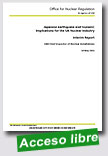 |
Japanese earthquake and tsunami: Implications for the UK Nuclear Industry - Interim Report
Office for Nuclear Regulation (UK), 18 May 2011, 122 p.
An interim assessment of the implications of the nuclear crisis in Japan concludes there is no need to curtail the operations of nuclear plants in the UK but lessons should be learnt.
|
Extraído de:
http://web.mit.edu/mitei/research/studies/nuclear-fuel-cycle.shtml
|
 |
 |
A Framework for an Integrated Risk Informed Decision Making Process
IAEA INSAG Series, 2011, 23 p.
Experience has shown that an integrated decision making process, including deterministic and probabilistic analyses together with good engineering practices, consideration of operating experience and sound managerial arrangements, is effective in refining and improving safe design and safe operation of nuclear installations. This publication is intended to promote a common understanding among the international nuclear community of how the concept of risk can be used in |
making safety decisions relating to nuclear installations. It identifies the framework, principles and key elements for integrated risk informed decision making (IRIDM) and describes the interrelationship between the key elements as well as the integration of their input. Although this publication is focused on the use of IRIDM in the context of nuclear power plants, including their fuel handling and storage systems, it can be equally applied with appropriate adjustments to other nuclear facilities and activities as well as to non-nuclear applications.
Extraído de:
http://www-pub.iaea.org/MTCD/publications/PubDetails.asp?pubId=8577
|
 |
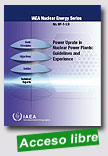 |
The process of increasing the licensed power level of a commercial nuclear power plant (NPP) is called "Power Uprate". In most cases this is an economic way of producing more electricity in a nuclear power plant, while maintaining adequate safety, design and operational margins. There are a number of options for uprating the power level and these are discussed in this publication. Furthermore it provides information on current trends, licensing aspects, monitoring, lessons learned from many countries and verification technology. |
Extraído de:
http://www-pub.iaea.org/MTCD/publications/PubDetails.asp?pubId=8433 |
 |
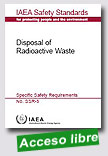 |
Disposal of Radioactive Waste Safety Requirements
IAEA Safety Standards Series No. SSR-5
IAEA Safety Standards Series No. SSR-5
This publication establishes requirements applicable to all types of radioactive waste disposal facility. It is linked to the fundamental safety principles for each disposal option and establishes a set of strategic requirements that must be in place before facilities are developed. Consideration is also given to the safety of existing facilities developed prior to the establishment of present day standards. The requirements will be complemented by Safety Guides that will provide guidance on
|
good practice for meeting the requirements for different types of waste disposal facility.
Contents: 1. Introduction; 2. Protection of people and the environment; 3. Safety requirements for planning for the disposal of radioactive waste; 4. Requirements for the development, operation and closure of a disposal facility; 5. Assurance of safety; 6. Existing disposal facilities; Appendices.
STI/PUB/1449, 62 pp.; 0 figures; 2011, ISBN 978-92-0-103010-8, English. 48.00 Euro Full Text, (File Size: 802 KB).
Extraído de:
http://www-pub.iaea.org/MTCD/publications/PubDetails.asp?pubId=8420 |
 |
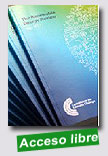 |
The Renewable Energy Review
Committee on Climate Change (UK), May 2011, 166 p.
In May 2010, the Government asked the Committee on Climate Change to review the potential for renewable energy development, and to advise on whether existing targets should be reviewed. We were asked to provide advice in two steps: (i) initial advice on whether the targets for 2020 should be raised; (ii) subsequent more detailed advice on appropriate ambition beyond 2020. In September 2010 we delivered our initial advice in a letter to the Secretary of State. We recommended that the 2020 target should not be increased but that policy should focus |
on ensuring that this stretching target is met. In this report we set out our conclusions on the potential for renewable energy – in electricity, heat and transport – in the period to 2030 and beyond. The report complements the conclusions and recommendations of our December 2010 report, The Fourth Carbon Budget – reducing emissions in the 2020s, which set out our recommendations for the fourth carbon budget. Later this year, we will publish a further report looking in particular at bioenergy. This will complete the. Renewable Energy Review and will form part of our broader advice on inclusion of aviation and shipping in carbon budgets, as required under the Climate Change Act, and to be published in spring 2012.
Extraído de:
http://www.theccc.org.uk/reports/renewable-energy-review
|
 |
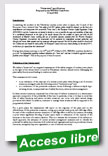
|
The proposal by the WENRA Task Force about “Stress tests” specifications
Western European Nuclear Regulator´s Association (WENRA), 21 April 2011
Considering the accident at the Fukushima nuclear power plant in Japan, the Council of the European Unión declared that "the safety of all EU nuclear plants should be reviewed, on the basis of a comprehensive and transparent risk assessment ("stress tests"); the European Nuclear Safety Regulatory Group (ENSKEG) and the Commission are invited to develop as soon as possible the scope and modalities of these tests in a |
coordinated framework in the light of the lessons learned from the accident in Japan and with the full involvement of Member States, making full use of available expertise (notably from the Western European Nuclear Regulators Ajsociation); the assessments mil be conducted by indpendent national authorities and through peer review; their outcome and any necessary subsequent measures that will be taken should be shared with the Commission and should be made public; the European Council will assess initial findings by the end of 2011, on the basis of a rport from the Commission".
Dunng their plenary meeting on the 22nd and 23rd of March 2011, WENRA members decided to provide "an independent regulatory technical definition of a "stress test" and how it should be applied to nuclear across Europé". This is the purpose of this document.
Extraído de:
http://www.wenra.org/dynamaster/file_archive/110421/
0ea2c97b35d658d73d1013f765e0c87d/StressTestsSpecifications2011-04-21.pdf
|
 |
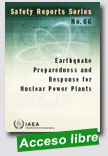 |
Earthquake Preparedness and Response for Nuclear Power Plants
IAEA Safety Reports Series, 2011, 185 p.
This Safety Report provides up to date detailed guidance on actions to be taken in preparation for, and following, an earthquake at a nuclear power plant, taking into account the gained knowledge and experience of Member States from the occurrence of strong earthquakes that affected nuclear power plants up to 2010. The publication is a compilation of available references based on related standards and proposes a more |
comprehensive set of criteria than the existing ones in some national regulations, based on damage and earthquake exceedance levels for dealing with situations related to plant shutdown, plant restart or plant continuing operation following the occurrence of an earthquake which may exceed the original design level. It will be a useful tool for regulatory bodies, specialists on earthquake engineering and technical support organizations.
Extraído de:
http://www-pub.iaea.org/MTCD/publications/PubDetails.asp?pubId=8473
|
 |
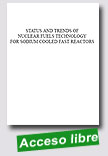 |
Status and Trends of Nuclear Fuel Technology for Sodium Cooled Fast Reactors
IAEA Nuclear Energy Series, 2011, 113 p.
From the inception of nuclear energy, the important role of the sodium cooled fast reactor (SFR) and its fuel cycle has been recognized for long term sustainability of nuclear power. This publication covers the status and trends of SFR fuel technology, highlighting manufacturing processes, out-of-pile properties and irradiation behaviour of mixed uranium–plutonium oxide (MOX), monocarbide (MC), mononitride (MN) and metallic U–Zr and |
U–Pu–Zr fuels. Minor actinide (Np, Am, Cm) bearing fuels are also covered in this publication. The information compiled in this book will be a valuable resource for materials scientists and engineers involved in fuel development for fast reactors in general and sodium cooled fast reactors in particular.
Extraído de:
http://www-pub.iaea.org/MTCD/publications/PubDetails.asp?pubId=8333
|
 |
| 
|
IAEA International Fact Finding - Expert Mission of the Nuclear Accident Following the Great East Japan Earthquake and Tsunami - Preliminary Summary
IAEA, June 2011, 5 p.
A team of international nuclear safety experts today completed a preliminary assessment of the safety issues linked with TEPCO's Fukushima Daiichi Nuclear Power Station accident following the Great East Japan Earthquake and Tsunami. The team - created by an agreement of the IAEA and the Government of Japan - sought to identify lessons learned from the accident that can help improve nuclear safety around the world.
|
|
|
|
